#sauce fromage
Text





#food#foodpics#food and drink#foodlover#junk food#tacos#sauce fromage#junkfooddaily#lovefood#j’aime trop manger#healthy#miam#bon appetit#my oasis#fast food restaurants#fast food#Spotify
0 notes
Text

Poutine
Contribution de notyourlilhomie.
23 notes
·
View notes
Text
Friands au Fromage

These delectably cheesy Friands au Fromage are a simple and delicious lunch to tuck into after installing Christmas lights in the front garden! The beautifully strong flavour of Epoisses make them appropriately festive, too! Happy Saturday!
Ingredients (makes 2 large friands):
1 cup Béchamel Sauce
Parmesan
300 grams/10.5 ounces Rough Puff Pastry
60 grams/2 ounces Epoisses (or another strong cheese like Muenster or Maroilles; unless you prefer something milder...)
1 egg
3/4 teaspoon freshly cracked black pepper
In a medium saucepan over a low flame, heat Béchamel Sauce. Grate in about 2/3 cup Parmesan. Cook, until cheese has completely melted. Remove from the heat, and let cool completely.
Preheat oven to 200°C/395°F.
Line a baking tray with baking paper. Set aside.
Roll Rough Puff Pastry out onto a lightly floured surface, into a large (30cmx25cm/12″x10″) rectangle. Divide into two equal rectangles, and place them onto prepared baking tray.
Cut Epoisses cheese into slices. Lightly beat the egg.
Spoon about 1/3 cup of the Parmesan Béchamel mixture in the centre of each Puff Pastry rectangle. Grate a little more Parmesan onto the Béchamel, and top each with slices of Epoisses.
Cut the edges of the Puff Pastry rectangles into strips, up to the filling, and fold them over each other, pressing in the middle, where strips meet, to seal.
Generously brush friands with egg wash. Sprinkle each generously with cracked black pepper.
Place in the middle of the hot oven, and bake, at 200°C/395°F, 20 to 25 minutes until golden brown.
Serve Friands au Fromage hot or warm, with dressed lettuce or a bowl of soup.
#Recipe#Food#Friands au Fromage#Friands au Fromage recipe#Cheese Friands#Cheese Friand recipe#Friands#Puff Pastry#Rough Puff Pastry#Homemade Puff Pastry#Béchamel#Béchamel Sauce#Bechamel Sauce#Parmesan#Parmesan Cheese#Epoisses#Epoisses Cheese#Cheese#Egg#Egg Wash#Black Pepper#Black Peppercorns#Savoury Pie Tart and Pizza#Quick recipe#Easy recipe#Cold Weather recipe#Comfort Food#French Cuisine
8 notes
·
View notes
Text
J'ai envie d'une fondue bourguignonne avec de la sauce béarnaise, accompagné d'un vrai gratin dauphinois
8 notes
·
View notes
Text
Aliments riches en glutamate
Mots-clés de la recherche : does pumpkin contains glutamate
https://www.webmd.com/diet/high-glutamate-foods
#a priori pas de glutamate dans la citrouille donc#mais dans les fromages sauces asiatiques noix tomates jus poissons champignons legumes amidonés comme patates et maïs
0 notes
Text
La soupe à l'oignon 5 ou 6 gros oignons jaunes coupés finement 3 cuillères à soupe de beurre 4 gousses d’ail émincées 3 cuillères à soupe de farine 1/2 tasse (125 ml) de vin blanc sec 6 tasses (1500 ml) de bouillon de bœuf 1 cuillère à thé de sauce Worcestershire 1 feuille de laurier 3 branches de thym sel et poivre pain baguette fromage
28 notes
·
View notes
Photo
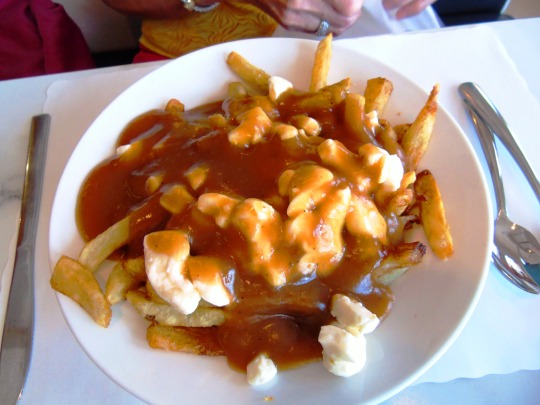
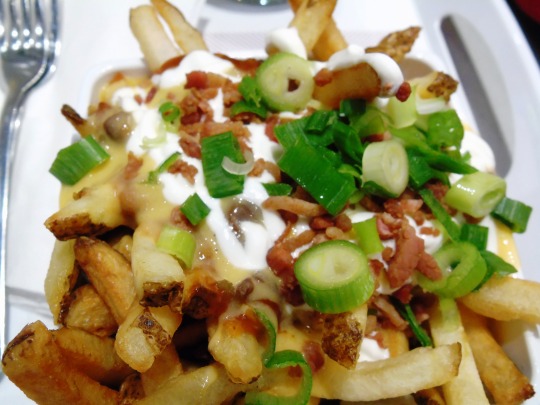


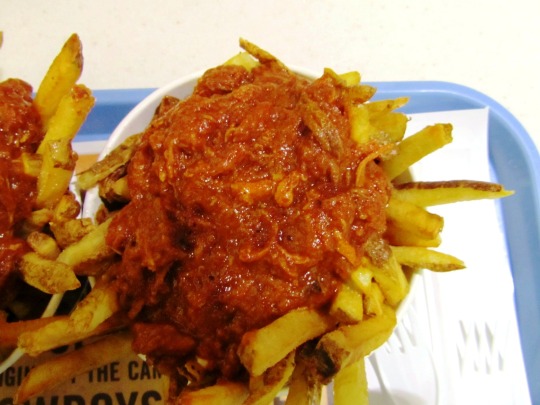
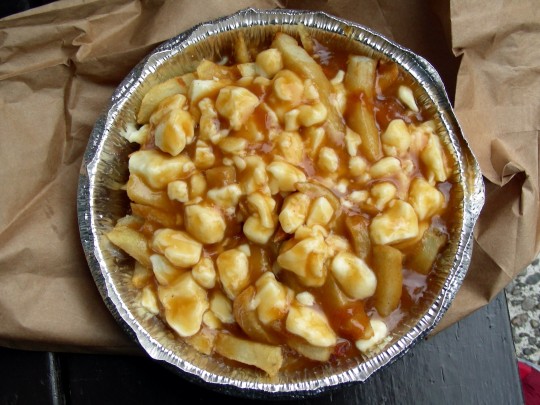
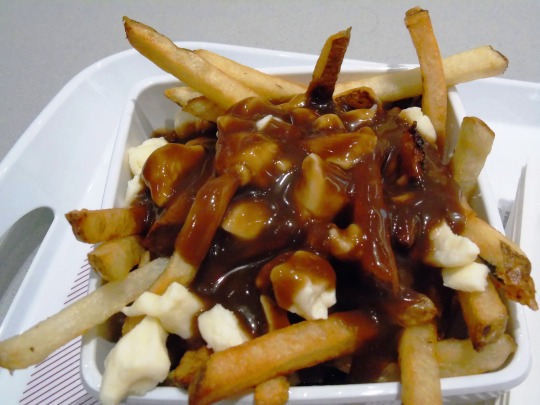
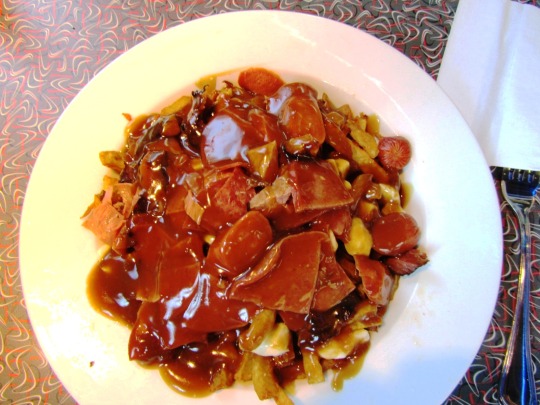

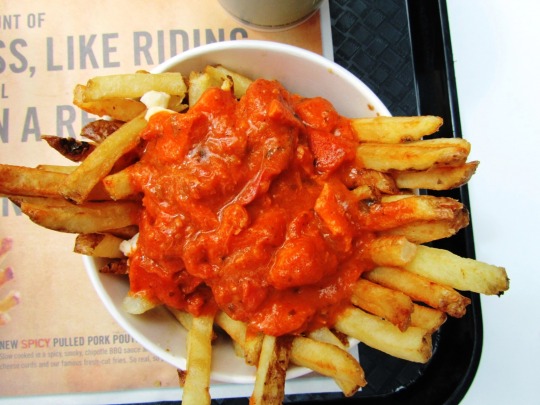
National Poutine Day
In Canada, particularly in Quebec, poutine is a staple food, if not also an iconic one. It has become a popular food in America as well as in other countries, and we celebrate it today, on National Poutine Day. Standard poutine is made up of fresh-cut french fries, squeaky fresh cheese curds, and brown gravy, but there are many variations of the dish. Among other possibilities, the name may have come from the word "pudding," which is spelled pouding in French, or from poutine, which is slang for "mess" in Quebec. It is pronounced "pou-tin" in the French-dominated regions of Quebec and New Brunswick, but as "poo-teen" elsewhere.
According to the most widely known and accepted story, poutine was first served at L’Idéal (Café Ideal)—a restaurant that later changed its name to Le Lutin Qui Rit (The Laughing Elf)—in 1957, in the small town of Warwick, in Arthabaska County, Quebec, a town known for producing squeaky cheese curds. A usual customer, Eddy Lainsesse, requested curds on top of his fries. The restaurant owner, Fernand Lachance, supposedly replied, "Ça va faire une maudite poutine," which roughly translates to "That's going to make a dreadful mess." A variation of the story says that Lainsesse asked for the curds and fries to be thrown together in a paper bag, upon which Lachance looked into the bag and said, "This is poutine." The dish started being sold in a bag and soon caught on. Patrons began adding ketchup and vinegar to it. In 1963, Lachance began serving it on plates. Customers soon noticed that the fries got cold quickly, so Lachance added gravy to keep them warm.
According to another story, poutine was created by Jean-Paul Roy, owner of Le Roy Jucep, a drive-in restaurant in Drummondville, Quebec. He had been serving a dish of gravy and french fries called patate-sauce since 1958, and in 1964 noticed that some of his diners were adding cheese curds to it. He soon added a dish that contained all three ingredients and named it fromage-patate-sauce.
No matter how poutine got its start, it soon could be found being sold as street food in Canada. By 1969 it was being sold in Quebec City at the Ashton Snack Bar food truck on Boulevard Wilfred-Hamel, and it was being sold in Montreal by 1983. By the early 1980s, it had become a widely popular street food in Ontario and Quebec.
It made its debut in Canadian chain restaurants in 1985, appearing on the menu at Frits, a now-defunct Quebec-based chain. By the 1990s, poutine had reached mass popularization in the country, after its inclusion on the menus of other chains. It first appeared on a Burger King menu in 1987 in Quebec, and soon spread to other locations of the chain. The same happened with McDonald's in 1990. Canadian fast-food chain Harvey's debuted it on menus across the country in 1992.
But poutine wasn't to remain only as street food and fast food. By the early 2000s, it was appearing in high-end Canadian restaurants. It was put on the menu at Aud Pied de Cochon in Montreal in 2002, where it was topped with foie gras. Other high-end Montreal restaurants followed suit. Garde Manger began serving an Iron Chef America-winning lobster poutine, and Pub Quartier Latin put poutine made with steak, truffles, and red wine demi-glace on their menu.
Some Canadian restaurants have made poutine their main focus. La Banquise in Montreal began serving it in the 1980s. They started with the standard version and an Italian version with bolognese sauce instead of gravy. They have since expanded to serving 30 types. Smoke's Poutinerie was started in Toronto in 2008, the first poutine-only restaurant in that city. Other poutine-only restaurants that followed in Canada are Poutini's House of Poutine, La Poutinerie, and Poutineville.
Poutine made its first foray into the United States in New Jersey and New York, where a variation of the recipe called "Disco Fries" became popular. This version substituted mozzarella or cheddar cheese for the curds. Poutine has since become relatively common in the States, and took hold in other countries as well, such as the United Kingdom and Russia.
As mentioned, there are various types of poutine besides the usual french fries, cheese curds, and gravy combination. Different types of potatoes, cheese, and sauces can be used. Italian poutine may use spaghetti sauce instead of gravy; veggie poutine is made with mushroom sauce and vegetables; Irish poutine is made with lardons. La galvaude is from Gaspésie and is made with chicken and green peas. A variation in Montreal uses smoked meat.
Festivals devoted to poutine are held across Canada throughout the year. Montreal, Ottawa, and Toronto are some cities that hold them. On National Poutine Day, events are held and specials are available at restaurants in countries like Canada and the United States. For example, My Meatball Place in Toronto has given away free samples of meatball and vegan poutine, and The Hops Spot in Syracuse has offered half-price poutine. With so many types of poutine—and so many restaurants that serve it in some parts of the world—there is no reason to remain hungry on National Poutine Day.
How to Observe National Poutine Day (Canada)
Here are some ideas on how to celebrate the day:
Make your own poutine. You could make the original version or another variation of the dish. You could even make Disco Fries, the Americanized version of the dish.
Check if there is a place near you that serves poutine.
Enjoy poutine at a Canadian restaurant that specializes in the dish, such as La Banquise, Smoke's Poutinerie, Poutini's House of Poutine, La Poutinerie, or Poutineville. Smoke's Poutinerie also has some locations in the United States.
Have poutine at a restaurant in Warwick, Quebec, the town where the dish is said to have originated, or have it at Le Roy Jucep in Drummondville, Quebec, the other location where it is said to have gotten its start.
Eat some poutine at Harvey's or at another fast food restaurant in Canada.
Enjoy poutine at a high-end Canadian restaurant such as Aud Pied de Cochon, Garde Manger, or Pub Quartier Latin.
See if there are any specials on poutine today at restaurants such as My Meatball Place in Toronto or The Hops Spot in Syracuse.
Plan a trip to an upcoming poutine fest, such as Montreal's Le Grand Poutinefest, Ottawa Poutine Fest, or Toronto Poutine Fest.
Source
#Poutine 911#Le Roy Jucep#the original one#Drummondville#Québec#travel#summer 2015#food#fries#cheese curd#gravy#restaurant#Poutine the Works#Bacon Double Cheese Poutine#Pulled Pork Poutine#Butter Chicken Poutine#Meat Lovers Poutine#National Poutine Day#Canada#NationalPoutineDayCanada#11 April#street food#vacation#2018#2012#Montréal
92 notes
·
View notes
Text
Identity V x Sweet Paradise Butler's Cafe
Menu


Mechanic Set
Food : Tracy's "Perfect Piece" Quiche Plate
Drink : Tracy's Peach Soda with Perennial Flowers
Violinist Set
Food : Tomato sauce pasta that plays music with you
Drink : Antonio's non-alcoholic sangria
Wu Chang Set
Food : Black curry on a sunny day
Drink : Wu Chang's relaxing wiener coffee
Coordinator Set
Food : Soaring sky chicken poiret
Drink : Awakening to a cup of Martha's Sky Orange Tea
Photographer Set
Dessert : (Special dessert platter) Elegant afternoon tea set
Drink : Have a beautiful afternoon with Earl Gray served by Joseph
Prisoner Set
Dessert : Special tiramisu plate to pamper young master
Drink : Shining ice energy drink
Gravekeeper Set
Dessert : Blissful fromage that will invites you to utopia
Drink : Andrew's relaxing grape soda
Painter Set
Dessert : Golden ratio crème brulee
Drink : Edgar's fresh golden ginger ale
Novelty

- Everytime you bought 1 food/dessert, you will receive 1 random bookmark
- Everytime you bought 1 drink, you will receive 1 random coaster

When you vote, you will receive 1 random thank you card from the characters
Merchandises


- Acrylic stand
- Badge
- Name tag badge
- Clearfile
- Compact mirror
- Character motif Scarf
Lottery

Prize
A Prize : Canvas art
B Prize : Clear bookmark
C Prize : Coaster
For more information :
#identity v#idv#idv x suipara#idv cafe#idv prisoner#luca balsa#idv grave keeper#andrew kreiss#idv painter#edgar valden#idv coordinator#martha behamfil#idv mechanic#tracy reznik#idv wu chang#idv violinist#idv antonio#idv photographer#joseph desaulnier
13 notes
·
View notes
Note
Cheese is a dairy product produced in wide ranges of flavors, textures, and forms by coagulation of the milk protein casein. It comprises proteins and fat from milk (usually the milk of cows, buffalo, goats, or sheep). During production, milk is usually acidified and either the enzymes of rennet or bacterial enzymes with similar activity are added to cause the casein to coagulate. The solid curds are then separated from the liquid whey and pressed into finished cheese. Some cheeses have aromatic molds on the rind, the outer layer, or throughout.
A platter with cheese and garnishes
Cheeses in art: Still Life with Cheeses, Almonds and Pretzels, Clara Peeters, c. 1615
Over a thousand types of cheese exist and are produced in various countries. Their styles, textures and flavors depend on the origin of the milk (including the animal's diet), whether they have been pasteurized, the butterfat content, the bacteria and mold, the processing, and how long they have been aged. Herbs, spices, or wood smoke may be used as flavoring agents. The yellow to red color of many cheeses is produced by adding annatto. Other ingredients may be added to some cheeses, such as black pepper, garlic, chives, or cranberries. A cheesemonger, or specialist seller of cheeses, may have expertise with selecting, purchasing, receiving, storing and ripening cheeses.
For a few cheeses, the milk is curdled by adding acids such as vinegar or lemon juice. Most cheeses are acidified to a lesser degree by bacteria, which turn milk sugars into lactic acid, then the addition of rennet completes the curdling. Vegetarian alternatives to rennet are available; most are produced by fermentation of the fungus Mucor miehei, but others have been extracted from various species of the Cynara thistle family. Cheesemakers near a dairy region may benefit from fresher, lower-priced milk, and lower shipping costs.
Cheese is valued for its portability, long shelf life, and high content of fat, protein, calcium, and phosphorus. Cheese is more compact and has a longer shelf life than milk, although how long a cheese will keep depends on the type of cheese. Hard cheeses, such as Parmesan, last longer than soft cheeses, such as Brie or goat's milk cheese. The long storage life of some cheeses, especially when encased in a protective rind, allows selling when markets are favorable. Vacuum packaging of block-shaped cheeses and gas-flushing of plastic bags with mixtures of carbon dioxide and nitrogen are used for storage and mass distribution of cheeses in the 21st century.
Etymology
Various hard cheeses
The word cheese comes from Latin caseus,from which the modern word casein is also derived. The earliest source is from the proto-Indo-European root *kwat-, which means "to ferment, become sour". That gave rise to cīese or cēse (in Old English) and chese (in Middle English). Similar words are shared by other West Germanic languages—West Frisian tsiis, Dutch kaas, German Käse, Old High German chāsi—all from the reconstructed West-Germanic form *kāsī, which in turn is an early borrowing from Latin.
The Online Etymological Dictionary states that "cheese" comes from:
Old English cyse (West Saxon), cese (Anglian) ... from West Germanic *kasjus (source also of Old Saxon kasi, Old High German chasi, German Käse, Middle Dutch case, Dutch kaas), from Latin caseus [for] "cheese" (source of Italian cacio, Spanish queso, Irish caise, Welsh caws).
The Online Etymological Dictionary states that the word is of:
unknown origin; perhaps from a PIE root *kwat- "to ferment, become sour" (source also of Prakrit chasi "buttermilk;" Old Church Slavonic kvasu "leaven; fermented drink," kyselu "sour," -kyseti "to turn sour;" Czech kysati "to turn sour, rot;" Sanskrit kvathati "boils, seethes;" Gothic hwaþjan "foam"). Also compare fromage. Old Norse ostr, Danish ost, Swedish ost are related to Latin ius "broth, sauce, juice."
When the Romans began to make hard cheeses for their legionaries' supplies, a new word started to be used: formaticum, from caseus formatus, or "molded cheese" (as in "formed", not "moldy"). It is from this word that the French fromage, standard Italian formaggio, Catalan formatge, Breton fourmaj, and Occitan fromatge (or formatge) are derived. Of the Romance languages, Spanish, Portuguese, Romanian, Tuscan and Southern Italian dialects use words derived from caseus (queso, queijo, caș and caso for example). The word cheese itself is occasionally employed in a sense that means "molded" or "formed". Head cheese uses the word in this sense. The term "cheese" is also used as a noun, verb and adjective in a number of figurative expressions (e.g., "the big cheese", "to be cheesed off" and "cheesy lyrics").
A piece of soft curd cheese, oven-baked to increase shelf life
Cheese is an ancient food whose origins predate recorded history. There is no conclusive evidence indicating where cheesemaking originated, whether in Europe, Central Asia or the Middle East. Earliest proposed dates for the origin of cheesemaking range from around 8000 BCE, when sheep were first domesticated. Since animal skins and inflated internal organs have, since ancient times, provided storage vessels for a range of foodstuffs, it is probable that the process of cheese making was discovered accidentally by storing milk in a container made from the stomach of an animal, resulting in the milk being turned to curd and whey by the rennet from the stomach.
The earliest evidence of cheesemaking in the archaeological record dates back to 5500 BCE and is found in what is now Kuyavia, Poland, where strainers coated with milk-fat molecules have been found.
Cheesemaking may have begun independently of this by the pressing and salting of curdled milk to preserve it. Observation that the effect of making cheese in an animal stomach gave more solid and better-textured curds may have led to the deliberate addition of rennet. Early archeological evidence of Egyptian cheese has been found in Egyptian tomb murals, dating to about 2000 BCE. A 2018 scientific paper stated that the world's oldest cheese, dating to approximately 1200 BCE (3200 years before present), was found in ancient Egyptian tombs.
The earliest cheeses were likely quite sour and salty, similar in texture to rustic cottage cheese or feta, a crumbly, flavorful Greek cheese. Cheese produced in Europe, where climates are cooler than the Middle East, required less salt for preservation. With less salt and acidity, the cheese became a suitable environment for useful microbes and molds, giving aged cheeses their respective flavors. The earliest ever discovered preserved cheese was found in the Taklamakan Desert in Xinjiang, China, dating back as early as 1615 BCE (3600 years before present).
Ancient Greece and Rome
Cheese in a market in Italy
Ancient Greek mythology credited Aristaeus with the discovery of cheese. Homer's Odyssey (8th century BCE) describes the Cyclops making and storing sheep's and goats' milk cheese (translation by Samuel Butler):
We soon reached his cave, but he was out shepherding, so we went inside and took stock of all that we could see. His cheese-racks were loaded with cheeses, and he had more lambs and kids than his pens could hold...
When he had so done he sat down and milked his ewes and goats, all in due course, and then let each of them have her own young. He curdled half the milk and set it aside in wicker strainers.
Columella's De Re Rustica (c. 65 CE) details a cheesemaking process involving rennet coagulation, pressing of the curd, salting, and aging. According to Pliny the Elder, it had become a sophisticated enterprise by the time the Roman Empire came into being.
Cheese, Tacuinum sanitatis Casanatensis (14th century)
As Romanized populations encountered unfamiliar newly settled neighbors, bringing their own cheese-making traditions, their own flocks and their own unrelated words for cheese, cheeses in Europe diversified further, with various locales developing their own distinctive traditions and products. As long-distance trade collapsed, only travelers would encounter unfamiliar cheeses: Charlemagne's first encounter with a white cheese that had an edible rind forms one of the constructed anecdotes of Notker's Life of the Emperor.
The British Cheese Board claims that Britain has approximately 700 distinct local cheeses; France and Italy have perhaps 400 each (a French proverb holds there is a different French cheese for every day of the year, and Charles de Gaulle once asked "how can you govern a country in which there are 246 kinds of cheese?"). Still, the advancement of the cheese art in Europe was slow during the centuries after Rome's fall. Many cheeses popular today were first recorded in the late Middle Ages or after—cheeses like Cheddar around 1500, Parmesan in 1597, Gouda in 1697, and Camembert in 1791.
In 1546, The Proverbs of John Heywood claimed "the moon is made of a green cheese" (Greene may refer here not to the color, as many now think, but to being new or unaged). Variations on this sentiment were long repeated and NASA exploited this myth for an April Fools' Day spoof announcement in 2006.
Cheese display in grocery store, Cambridge, Massachusetts, United States
Until its modern spread along with European culture, cheese was nearly unheard of in east Asian cultures and in the pre-Columbian Americas and had only limited use in sub-Mediterranean Africa, mainly being widespread and popular only in Europe, the Middle East, the Indian subcontinent, and areas influenced by those cultures. But with the spread, first of European imperialism, and later of Euro-American culture and food, cheese has gradually become known and increasingly popular worldwide.
The first factory for the industrial production of cheese opened in Switzerland in 1815, but large-scale production first found real success in the United States. Credit usually goes to Jesse Williams, a dairy farmer from Rome, New York, who in 1851 started making cheese in an assembly-line fashion using the milk from neighboring farms; this made cheddar cheese one of the first US industrial foods.Within decades, hundreds of such commercial dairy associations existed.
The 1860s saw the beginnings of mass-produced rennet, and by the turn of the century scientists were producing pure microbial cultures. Before then, bacteria in cheesemaking had come from the environment or from recycling an earlier batch's whey; the pure cultures meant a more standardized cheese could be produced.
Factory-made cheese overtook traditional cheesemaking in the World War II era, and factories have been the source of most cheese in America and Europe ever since.By 2012, cheese was one of the most shoplifted items from supermarkets worldwide.
I’M NOT GRADING YOUR INFORMATIVE ESSAY.
9 notes
·
View notes
Text
youtube
Amateur de fromage fondu, vous êtes en panne d'inspiration pour le repas ou l'apéro ? 🤔 Je vous propose une belle assiette de nachos sauce cheddar pour accompagner quelques crudités, des crevettes sautées, des beignets 🤤 Regardez la recette et essayez chez vous !
#food#cuisine#cook#nachos#cheddar cheese#nachos sauce cheddar#recette#recipe#snacks#chips nachos#chips mexicaine#tortilla chips#mexican food#Youtube
2 notes
·
View notes
Text
jsuis degoutee je croyais que j’avais de la sauce tomate ou au moins de la pulpe de tomate au fond d’un placard, gt prete a la cuisiner un peu, me faire un repas un peu cool et en fait j’en ai pas ????? mais g genre rien du tt g mm plus de creme fraiche ou quoi, meme plus de fromage pr des pates ou une brique de soupe ou un peu de pain, rien du tt genre mes options c pates a rien, semoule a rien ou roz a rien, a la limite g de la sauce soja donc riz sauce soja mais bon c pas trop mon del
2 notes
·
View notes
Text
Les crêpes a la viande: un plat savoureux et nourrissant
Les crêpes à la viande sont un plat traditionnel présent dans de nombreuses cultures à travers le monde. Elles constituent une alternative savoureuse et nourrissante aux crêpes sucrées, et peuvent être appréciées aussi bien en plat principal qu'en entrée ou en snack.

Un mélange de textures et de saveurs
La combinaison de la crêpe fine et moelleuse avec la garniture de viande hachée, accompagnée d'une sauce onctueuse, offre une expérience gustative unique. La viande peut être agrémentée de divers ingrédients, tels que des oignons, des champignons, des herbes aromatiques et des épices, pour créer une variété de saveurs et de textures.

Un plat versatile et personnalisable
Les crêpes à la viande peuvent être préparées avec différents types de viande, selon les goûts et les préférences. La viande hachée de bœuf, de porc, de poulet ou de dinde est généralement utilisée, mais des options plus audacieuses comme la viande de canard, de gibier ou de poisson peuvent également être explorées.
De multiples options de garniture et de sauce

La garniture des crêpes à la viande ne se limite pas à la viande hachée. Des légumes, du fromage, des œufs et d'autres ingrédients peuvent être ajoutés pour créer une variété de combinaisons. La sauce est également un élément important qui peut rehausser le goût de la crêpe. Une sauce béchamel, une sauce tomate, une sauce au fromage ou une simple sauce au yaourt peuvent être utilisées selon les préférences.
Un plat facile à préparer et à emporter
Les crêpes à la viande sont un plat relativement facile à préparer et ne nécessitent que peu d'ingrédients et de temps de cuisson. Elles peuvent être préparées à l'avance et réchauffées au moment de servir, ce qui les rend idéales pour les pique-niques, les déjeuners sur le pouce ou les repas rapides.
Une source de nutriments et d'énergie
Les crêpes à la viande constituent une source de protéines, de fibres et de glucides, ce qui en fait un repas nourrissant et énergétique. Elles peuvent être enrichies en vitamines et en minéraux en ajoutant des légumes et des fruits à la garniture.
Un plat convivial et festif
Les crêpes à la viande peuvent être servies lors de repas en famille ou entre amis. Elles constituent un plat convivial et festif qui permet de partager un moment gourmand et savoureux.
Conclusion
Les crêpes à la viande sont un plat simple, versatile et savoureux qui peut être apprécié par tous. Elles offrent une multitude de possibilités de personnalisation et constituent une source de nutriments et d'énergie. N'hésitez pas à explorer les différentes recettes et à créer vos propres combinaisons de saveurs pour découvrir le plaisir des crêpes à la viande.
3 notes
·
View notes
Text


Hier la journée a été TRÈS RICHE
J'ai plus ou moins raté mon oral de civilisation mais c'est pas grave parce qu'au moins c'est passé maintenant
J'ai donné mon CV et ma lettre de motivation pour Sevenoaks
J'ai passé beaucoup de temps avec mon amoureux, on a pris un petit déjeuner ensemble (bon vers 14h mais c'est un petit dej quand même, en plus ça faisait pas longtemps qu'il était réveillé), il a pas mal joué et on s'est préparés
C'est moi qui ai fait la cuisine hier soir, je lui ai préparé des pâtes (étonnamment ça faisait vraiment longtemps) et du coup j'avais préparé une petite sauce avec de la sauce tomate, les restes de champis, de l'oignon rouge et puis plein d'épices, c'était vraiment trop bon
C'était prévu que j'aille à la patinoire avec Pops et d'autres gens à 21h mais Fred commençait à 23h, je savais pas, du coup je leur ai dit que je viendrai un peu plus tard
J'ai voulu les attendre devant la patinoire mais c'était infini et il faisait froid alors on s'est rejoint directement chez Pops vers minuit, c'était un peu cringe ce moment là
Il y avait Pépin et Ferko, Jay et Ludo, et puis après il y a Morgane qui est venue avec garçon sympa qui s'appelle aussi Jason
JE DÉTESTE MORGANE ELLE ME MET TROP MAL A L'AISE ????
On a fini par décoller tant bien que mal pour aller à la barge avec Pepin, Pops et Jay
Mon dieu, je m'attendais archi pas à ça
Bon déjà la barge c'était vraiment cool pour une fois, il y avait du bon son. A un moment je sors fumer et il y avait un garçon assis sur le petit poteau, il me regarde et il sourit puis il me demande de lui raconter une anecdote
Il avait l'air vraiment super sympa et touchant alors je me suis assise et je lui ai raconté l'anecdote de la teuf, je lui ai demandé de me raconter une anecdote aussi et au final on a discuté super super longtemps
Il s'appelle Tom et il a 30 ans, si je me souviens bien je crois qu'il habite plus vraiment sur Troyes
On a beaucoup beaucoup parlé de littérature c'était trop chouette, on a parlé de la Voleuse de Livres avec son ami aussi
On s'est vraiment bien entendu et il a même décidé de me payer un verre "parce que je lis des livres et que c'est vraiment chouette"
Ça m'a vraiment fait plaisir de le rencontrer et d'avoir ces discussions
SEULEMENT
ENTRE TEMPS Y'A UN ZIGOTO QUI A BIEN BU (je crois) ET DONC
Je prends mon verre, je vois Jay
Jay commence a me bousculer gentiment pour rire, puis il me fait des guillis ????
Puis il me chope par la taille en se collant a moi et il me touche les seins ???
J'étais vraiment bien pétée mais j'étais pas à l'aise
Je pensais juste à mon amoureux
J'ai dit a Jay que c'était mort, qu'il ne se passerait pas quoi que ce soit mais on a continué à danser malgré tout
Et visiblement vu les messages que j'ai vu en me réveillant ce matin monsieur était vraiment deter pour avoir mon cul
"il reste quelque chose entre nous" PTDRRRRRR MDRRRRR ROULADE ARRIÈRE PIROUETTE
Après la barge on est rentrés chez Pops, je me rappelle plus vraiment du chemin mais je crois qu'on a croisé une fille avec une bombe de peinture et qu'on a graffé des coeurs <3
Chez Pops on a continué de boire encore un petit peu et puis Ferko et Pepin ont proposé de nous ramener en voiture Jay et moi
Entre temps mon amoureux m'avait envoyé plein de messages trop mims, il était prêt à venir me chercher à pieds pour être sûr que je rentre pas seule alors qu'il sortait du travail
Quand je suis rentrée c'était vraiment trop bien, j'étais tellement heureuse et soulagée de retrouver ses bras. Pendant la soirée la situation avec Jay m'avait un peu mis la pression mais bam là tout allait mieux et tout était trop chouette
Il avait même ramené de la pizza 4 fromages parce qu'il se doutait que j'aurais faim avec l'alcool etc
On s'est posés dans le canap et on a discuté et ris aux éclats pendant plus d'une heure et ensuite zou direction le groooos dodo
C'était une soirée marrante
(ah oui et aussi: apparemment j'ai dit à Fred hier soir (enfin ce matin du coup) que c'est Pops qui me l'avait donné et que c'est effectivement de la beuh bien qu'on ait un doute que ce soit du CBD, mais quoi qu'il en soit ça m'a fait tout drôle tout a l'heure d'ouvrir ma pochette et de voir l'équivalent d'un 30 balles sorti de nulle part 😂)
2 notes
·
View notes
Text

La recette des parfaites pâtes cacio pepe e limone
Pour 4 personnes.
Ingrédients :
- 360gr de spaghetti
- 220gr de Pecorino Romano
- 25gr de poivre noir
- 1 citron jaune
Préparation :
POUR LE PECORINO :
Râper finement le pecorino et moudre le poivre.
POUR LES SPAGHETTI :
Cuire les spaghetti dans de l'eau salée pour trois quarts de leur cuisson. Dans le même temps, mettre une poêle à chauffer avec le poivre.
Une fois passé les trois quarts de cuisson, passer les spaghetti dans la poêle, ajouter un peu d'eau de cuisson et terminer la cuisson des spaghetti al dente.
Puis faire la liaison avec le pecorino.
Dressage :
Disposer les spaghetti dans une assiette creuse. Terminer avec du poivre noir et des zestes de citron.
NB : La recette utilise un principe commun dans la cuisine italienne, celui d'utiliser l'amidon de l'eau bouillante et salée de cuisson comme liant pour créer une sauce riche et onctueuse. La chaleur fait fondre le fromage, tandis que l'amidon dans l'eau aide à lier le poivre et le fromage dans les pâtes
3 notes
·
View notes
Text
Salut Emmanuel Macron Bernard Arnault,
(Shawarma Influence)
Salade Roulée French Grill Cuisine
Fromages-Spinach-Dried Cranberry House Salade^
Root Végétale Gratin^
Sun-dried Tomatoes^
Homefries^
Eggs^
French Onion Sauce^
Game Meat*
Battered Fish*
Pocket Pita
Poutine Variété (Side)
^Salade
*Méat Options
Salut,
Adrian Blake-Trotman
2 notes
·
View notes
Text
J14▪️ Bad Sooden-Allendorf - Eschwege
24,5 km [304,6]▫️+595 m [+6 285]▫️22 °C
Aujourd’hui est un jour particulier, c’est le jour de la mi-parcours : nous avons fait autant d’étapes avant ce jour qu’il nous restera à faire après ce jour.
Un bilan ? Bah, on a échappé à la canicule. C’est sûr que vu d’ici, le mois de juillet le plus chaud de l’histoire du globe est une réalité très lointaine, les grands parasols des terrasses servant surtout à protéger les clients de la pluie et la petite laine étant de rigueur.
Physiquement ? À ce jour, pas de gros bobos et en tout cas pas d’ampoules, mais comme on marche longtemps, on sent quand même un peu de fatigue. Talons, genoux et épaules manifestent quelquefois contre leurs conditions de travail, mais le dialogue social et la concertation n'ont-ils pas raison de tout ? Pour l’instant oui.
Moralement ? Nickel, même si on aimerait un peu plus de soleil (une hêtraie ensoleillée est très belle, ça vous charmerait).
Germaniquement ? Ben on a pris le pli de manger tôt (6 heures - 6 heures et demi max). La carte bleue fait des progrès, mais la façon dont ils se retournent quand on fait le code démontre encore leur méfiance. La nourriture est bonne et locale. Hier soir nous avons dégusté la Hessische Grüne Soße (la sauce verte de Hesse), un plat composé d’oeufs durs (de plein air de la ferme Grenendörfer) recouverts d’un fromage blanc travaillé avec sept herbes (bourrache, cerfeuil, cresson, persil, pimprenelle, oseille, ciboulette) et servi avec des pommes de terre à l’eau. Délicieusement campagnard !
Bref ! Prêts pour l’autre moitié ! Et la Bavière !
4 notes
·
View notes